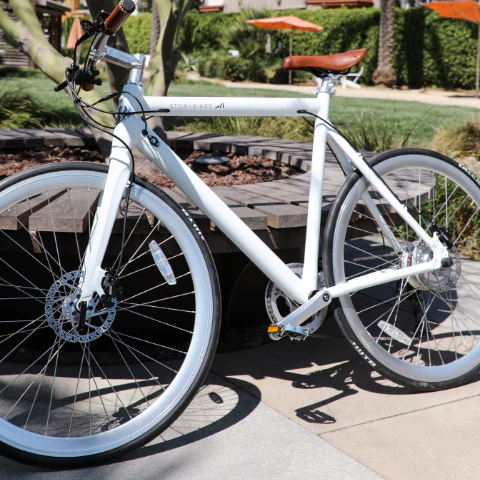Where Can I Ride My Electric Road Bike?
Â

Five years ago, most cyclists couldn’t even imagine owning an e-bike. These bikes were mostly seen as a rental option, and few people had one in their garage. But today, e-bikes are on the rise in popularity, and many riders are asking themselves: where can I ride my electric road bike safely?
The answer isn’t straightforward—it depends on local laws, safety rules, and the type of e-bike you have. Before heading out to a new area, it’s always a good idea to do a bit of research to make sure you’re riding legally and safely.
In this article, we’ll go over some common questions about where and how you can ride your e-bike.
Do I Need a License or Registration to Ride an E-Bike?
No, in most states and regions, you don’t need a special license to ride an e-bike. In fact, you usually don’t even need a driver’s license. However, there are exceptions. For example, in cities like Los Angeles, you may be required to register your e-bike like a vehicle. While enforcement might not be strict everywhere, failing to register could result in a fine.
Always check your local regulations before heading out. It’s better to be safe than sorry.
Can I Ride My E-Bike in the Bike Lane?
It depends. This varies based on local laws and the class of your e-bike. E-bikes are generally divided into three classes:
- Class 1: These e-bikes assist with pedaling and have a top speed of 20 mph.
- Class 2: These e-bikes have a throttle and also reach up to 20 mph.
- Class 3: These e-bikes can go up to 28 mph and often come with a speedometer. Some models may have a throttle, depending on local regulations.
In most places, Class 1 and Class 2 e-bikes are allowed in bike lanes and on roads. Class 3 e-bikes may be permitted too, but they often face stricter rules. Always verify local guidelines before riding.
What About Bike Trails?
Trail rules for e-bikes can vary widely. Some areas allow them, while others restrict or even ban e-bikes, especially on multi-use trails where pedestrians are present. Narrow paths are more likely to prohibit e-bike use due to space limitations.
Many trails permit Class 1 and Class 2 e-bikes but may not allow Class 3 models. If you're planning to ride on a trail, always check the specific rules for that area, as they may differ from general city or state laws.
A Final Note: Ebike Safety and Courtesy
If you find a place where e-bikes are allowed, remember to ride responsibly. E-bikes can move faster than traditional bikes and sometimes match traffic speeds, which can create challenges for other road users if not handled carefully.
Always wear a helmet and use hand signals when turning or stopping. Here are the standard hand signals:
- Left Turn: Extend your left arm straight out to the side.
- Right Turn: Extend your right arm straight out to the side. Note: Some states require a different signal—extend your left arm and bend it upward at a 90-degree angle.
- Stop/Slow Down: Extend your left arm and bend it downward at a 90-degree angle.
When passing cyclists, be polite and give them plenty of space—ideally at least three feet. Use a bell or horn to alert them if needed.
The Bottom Line
E-bikes come with their own set of rules, and these can vary greatly by location. Always double-check local regulations before taking your e-bike on a ride.
Ready to get on the road? Our range of step-through, road, and commuter e-bikes blends classic design with modern technology for a smooth and safe ride every time. Plus, for every bike we sell, we send one to a student in Zimbabwe.
If you're thinking about investing in an e-bike, browse our collection today. Don’t hesitate to reach out if you have any questions—we’re here to help!
Multi-layer co-extrusion functional film casting production line
Specifications
Film Structure 357
Screw aspect ratio 32: 1 32:1 32:1
Screw directly 75:125:75 75:75:90:75:75 75:65:75:65:75:65:75
Mold width 2500 2500 2500
Finished product width 2200 2200 2200
Finished product thickness 0.03mm-0.2mm 0.03mm-0.2mm 0.03mm-0.2mm
Maximum extrusion capacity 10 tons/24 hours 10 tons/24 hours 10 tons/24 hours
Mechanical design line speed 160 160 160
Total power 350KW 365KW 380KW
1 Advantages and characteristics of multi-layer co-extrusion cast film production line
| This production line can produce CPE, CPP, EVA, PETG, PVC, PES transparent, textured and breathable films.
| The screw is designed with special mixing function and high plasticizing capacity, combined with a special static mixer to ensure good plasticizing, good mixing effect and high output.
Jingcheng automatic adjustment die head and French Skender automatic thickness gauge can be selected to automatically detect film thickness online and automatically adjust die head.
|Large-diameter forming rollers and special spiral channel design ensure good film cooling and shaping effects at high speeds.
| Equipped with a negative pressure device to ensure the stability of the film melt film.
1 Film scraps are directly recycled online, greatly reducing production costs.
1. The drive of the whole machine is driven by a servo motor, and the constant torque ensures stable and efficient operation.
|Screw power adopts permanent magnet motor to save 20% of electricity.
|Strong after-sales team guarantees customers normal production without worries
I Fully automatic center crimping, automatic roll changing and cutting, easy to operate.
I multi-co-extrusion design can flexibly adjust the formula to reduce costs on the premise of ensuring product quality and functionality
The configuration is flexible and changeable, tailored according to the actual needs of customers, and the cost performance is maximized.
Multi-Layer Cast Film Line,Pvc Cast Film Line,Cpe Cast Film Line,Eva Cast Film Line
Baijia Mechanical Equipment (Huizhou) Co., Ltd. , https://www.castfilmmachine.com
